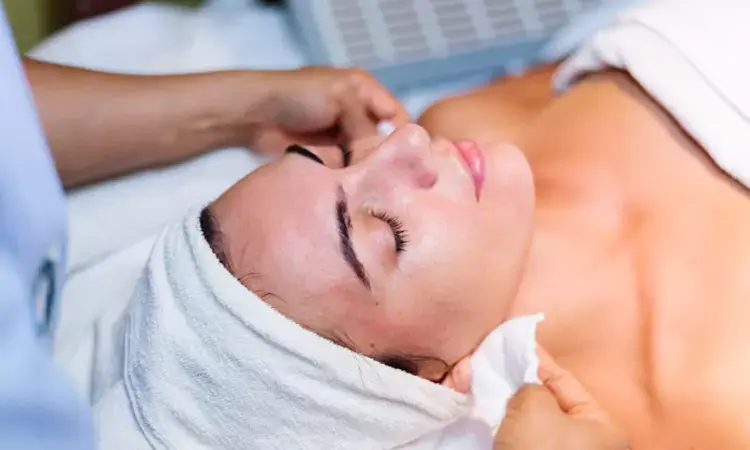- Home
- Medical news & Guidelines
- Anesthesiology
- Cardiology and CTVS
- Critical Care
- Dentistry
- Dermatology
- Diabetes and Endocrinology
- ENT
- Gastroenterology
- Medicine
- Nephrology
- Neurology
- Obstretics-Gynaecology
- Oncology
- Ophthalmology
- Orthopaedics
- Pediatrics-Neonatology
- Psychiatry
- Pulmonology
- Radiology
- Surgery
- Urology
- Laboratory Medicine
- Diet
- Nursing
- Paramedical
- Physiotherapy
- Health news
- Fact Check
- Bone Health Fact Check
- Brain Health Fact Check
- Cancer Related Fact Check
- Child Care Fact Check
- Dental and oral health fact check
- Diabetes and metabolic health fact check
- Diet and Nutrition Fact Check
- Eye and ENT Care Fact Check
- Fitness fact check
- Gut health fact check
- Heart health fact check
- Kidney health fact check
- Medical education fact check
- Men's health fact check
- Respiratory fact check
- Skin and hair care fact check
- Vaccine and Immunization fact check
- Women's health fact check
- AYUSH
- State News
- Andaman and Nicobar Islands
- Andhra Pradesh
- Arunachal Pradesh
- Assam
- Bihar
- Chandigarh
- Chattisgarh
- Dadra and Nagar Haveli
- Daman and Diu
- Delhi
- Goa
- Gujarat
- Haryana
- Himachal Pradesh
- Jammu & Kashmir
- Jharkhand
- Karnataka
- Kerala
- Ladakh
- Lakshadweep
- Madhya Pradesh
- Maharashtra
- Manipur
- Meghalaya
- Mizoram
- Nagaland
- Odisha
- Puducherry
- Punjab
- Rajasthan
- Sikkim
- Tamil Nadu
- Telangana
- Tripura
- Uttar Pradesh
- Uttrakhand
- West Bengal
- Medical Education
- Industry
Gluconolactone with multiple skin benefits ideal for use in cosmetic and dermatologic procedures

Poland: A recent study published in the Journal of Cosmetic Dermatology has shown a significant impact of gluconolactone (GLA) chemical peel treatment on lowering skin pH and transepidermal water loss (TEWL). GLA was also observed to have seboregulatory properties.
"GLA chemical peel treatment significantly lowered skin pH at all measurement points. Also, there was a significant reduction in TEWL around eyes, right cheek, and left forehead after GLA treatment," the researchers reported. "No significant differences were observed between different GLA concentrations."
The skin is a barrier to potentially harmful external factors, with a particular focus on protection against infection and water loss. The barrier's quality can be assessed using objective instrumental measurements that determine skin parameters such as pH, transepidermal water loss, sebum level, and hydration. Barrier disorders are affected by the use of irritants, chemicals, excessive degreasing (which can affect TEWL increase), internal factors, hormonal disorders, allergies, dermatological diseases, and dietary deficiencies.
Gluconolactone is an oxidized glucose lactone derivative. In nature, GLA is found in cheese, honey, wine, tofu, and fruit juices. GLA exhibits moisturizing and antioxidant effects. It also presents soothing effects, improves the function of the skin barrier, and protects elastin fibres from UV-induced degradation.
Sylwia Jarząbek-Perz, Medical University of Lódź, Lódź, Poland, and colleagues, therefore, aimed to evaluate skin parameters such as transepidermal water loss, pH, sebum levels before, during, and after a series of applications of 10% and 30% GLA chemical peel in a split-face model.
The study included 15 female subjects. Three split-face procedures were conducted using two GLA solution concentrations applied on two sides of the face. The skin parameters were measured before treatments and 7 days after the last procedure at four measurement sites on either side of the face, that is, on the forehead, on the cheek, around the eye, and on the nose wing.
The study led to the following findings:
- Measurement of sebum demonstrated some statistically significant changes between sebum levels in the cheeks after a series of treatments.
- The pH measurement showed a reduction in pH value after each treatment at all measurement points.
- The level of TEWL after treatments was significantly lower around the eyes, on the left forehead, and on the right cheek.
- There were no significant differences between the use of different concentrations of the GLA solution.
"The findings reveal the multiple skin benefits of gluconolactone, making it an ideal ingredient for use in cosmetology, cosmetic, and dermatologic procedures," the researchers concluded.
Reference:
Jarząbek-Perz, S., Dziedzic, M., Rotsztejn, H., & Kołodziejczak, A. (2023). Evaluation of the effects of 10% and 30% gluconolactone chemical peel on sebum, pH, and TEWL. Journal of Cosmetic Dermatology, 22(12), 3305-3312. https://doi.org/10.1111/jocd.15864
Dr Kamal Kant Kohli-MBBS, DTCD- a chest specialist with more than 30 years of practice and a flair for writing clinical articles, Dr Kamal Kant Kohli joined Medical Dialogues as a Chief Editor of Medical News. Besides writing articles, as an editor, he proofreads and verifies all the medical content published on Medical Dialogues including those coming from journals, studies,medical conferences,guidelines etc. Email: drkohli@medicaldialogues.in. Contact no. 011-43720751


